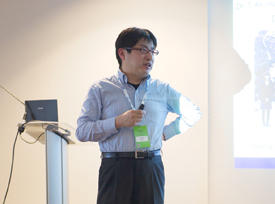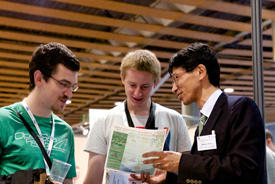

07/28/2014

From a new spin on electronics to tiny biological superhighways and beaming carbon-based transistors, researchers from the Advanced Institute for Materials Research (AIMR) presented their vision of the future of materials science at the 2014 Spring Meeting of the European Materials Research Society (E-MRS), the 32nd in a series of annual meetings held since 1983. “The E-MRS Spring Meeting is one of the most important conferences on materials science for the global community,” noted Masaru Tsukada, administrative director at the AIMR.
This year’s meeting, held on 26–30 May 2014 in Lille, northern France, was the society’s largest gathering since its establishment in 1983. Among the estimated 3,100 participants was a 44-strong team from Japan representing the World Premier International Research Center Initiative (WPI), a funding body that supports centers of excellence in basic science.
The four WPI participating institutes — the AIMR, the International Center for Materials Nanoarchitectonics, the Institute for Integrated Cell-Material Sciences and the International Institute for Carbon-Neutral Energy Research — shared their latest research with an attentive international audience at the meeting. Fourteen researchers from the AIMR — the highest number among the WPI institutes — gave presentations in subjects that included spin transport, protein vehicles and organic superconductors.
The highlight of the WPI team’s schedule was a half-day symposium titled “Japan in Motion”. Through a series of talks, the scientists introduced new ideas that are seizing the materials science community, from an atomic and molecular control approach to designing new structures based on nanoscale building blocks, to the successful alliances between materials science and mathematics that have emerged from a directed shift toward fusion research.
“Japan in Motion was a huge success,” said AIMR director, Motoko Kotani, who at the meeting was approached by many researchers eager to collaborate with the AIMR or move to Japan to conduct research at the institute. The symposium itself attracted an impressive 70 participants, and 400 individuals visited the associated WPI booth, including the current E-MRS president, Thomas Lippert, and former president, Ian Boyd.
In addition to the Japan in Motion event, WPI researchers shared their research at sessions organized over the course of the five-day meeting. In his presentation, Eiji Saitoh, a principal investigator at the AIMR, introduced his recent contributions to the technology of spintronics.
Spintronics seeks to manipulate the properties of spin and charge inherent in electrons for microelectronic device production. The technology is used in all commercially available disk drives today, and increasing control over electron spin could lead to even speedier data transfer and denser storage capacities. “The AIMR is one of the strongest institutes in the world for spintronics research,” said Saitoh.
Saitoh’s research builds on observations made in the early eighteenth century by German physicist Thomas Johann Seebeck, who discovered that temperature differences in a conductor can generate an electric current — a phenomenon aptly named the Seebeck effect. In 2008, Saitoh led the team of researchers that observed an analogous effect in electron spins in a magnet, identified as the spin-Seebeck effect. He has since been able to generate and measure a spin ‘voltage’ resulting from a change in temperature in a metal or insulating ferromagnet, an effect that could be exploited in spintronic devices or to improve the efficiency of existing heat sensors and waste heat recycling systems.
Intrigued by Saitoh’s presentation, a researcher from Germany suggested a method that could be used to control molecular spin. In a separate session, an independent investigator at the AIMR, Shigemi Mizukami, also shared his success in growing new manganese-based materials that could lead to terahertz-scale spintronic devices.

Improving energy efficiency by drawing inspiration from nature was central to the work presented by Aurélien Sikora, a research associate at the AIMR.
One natural system that ranks especially high on the energy-efficiency ladder is the motor protein kinesin — the subject of Sikora’s research. “Nature has a lot to teach us,” said Sikora. “The efficiency of motor proteins in energy conversion is unbeatable. We have to understand how to achieve such a level of performance to reduce energy waste and pollution.”
When loaded with goods, kinesin walks along microtubule roadways to transport its cargo throughout the cell. By turning kinesin proteins on their backs, scientists have been able to send microtubules ‘crowd surfing’ on the collective movement of the upward-facing kinesin legs. Sikora and his colleagues were able to demonstrate for the first time the potential for improving control of microtubule movement by confining the kinesin motors to narrow tracks made of carbon nanotubes.
Looking ahead, Sikora believes that using carbon nanotubes for protein-based transport could one day make it easier to control nanoparticle movement in biomedical devices, for example in conjunction with an electric field. Many participants at the E-MRS meeting were particularly interested in this ability to align the carbon nanotubes and asked numerous technical questions about Sikora’s findings.
A host of other fascinating materials were presented by AIMR researchers at the E-MRS meeting. Among them, principal investigator Mingwei Chen discussed the many merits of nanoporous metals fabricated through a process called dealloying, which gives them mechanical rigidity, a large surface area, electrical conductivity and high resistance to corrosion. And Taro Hitosugi, an associate professor, shared his findings from atomic-level investigations of a class of materials known as transitional metal oxides that exhibit compelling electron transport and magnetic properties.
In his poster presentation, Thangavel Kanagasekaran, a research associate at the AIMR, revealed he had successfully demonstrated an organic field-effect transistor that emits bright light at room temperature. Combining the ability to generate light with the electrical switching functionality of a transistor, this new class of optoelectronic device could improve visual display technologies and optical communication systems, and ultimately lead to the realization of electrically pumped organic lasers, he reported.
Kanagasekaran and the other AIMR and WPI delegates found that the interdisciplinary gathering in France offered an ideal venue to share ideas with their international counterparts. “All of the invited speakers from the AIMR took part in active and fruitful discussions with their peers,” added Director Kotani. “Our engagement with this interdisciplinary community has been very meaningful, and we will continue to pay attention to its activities.”